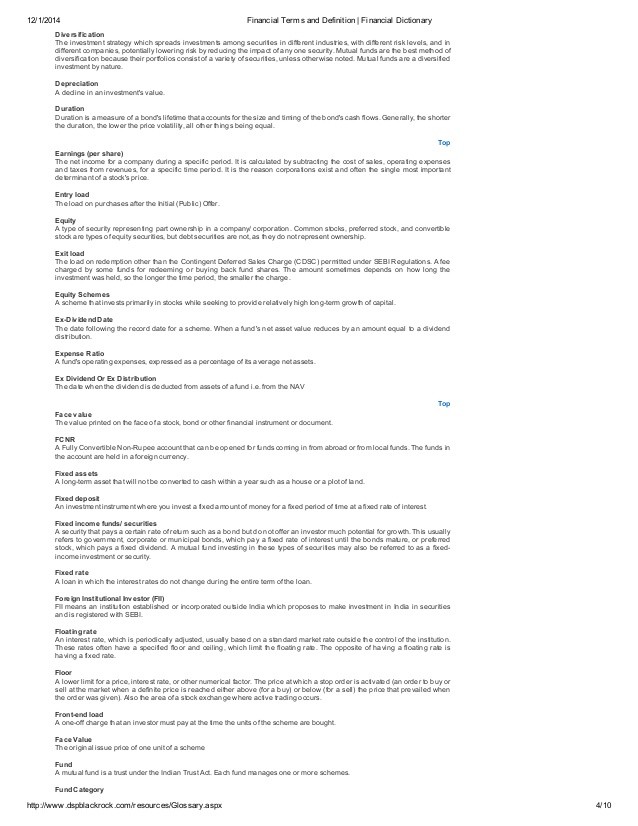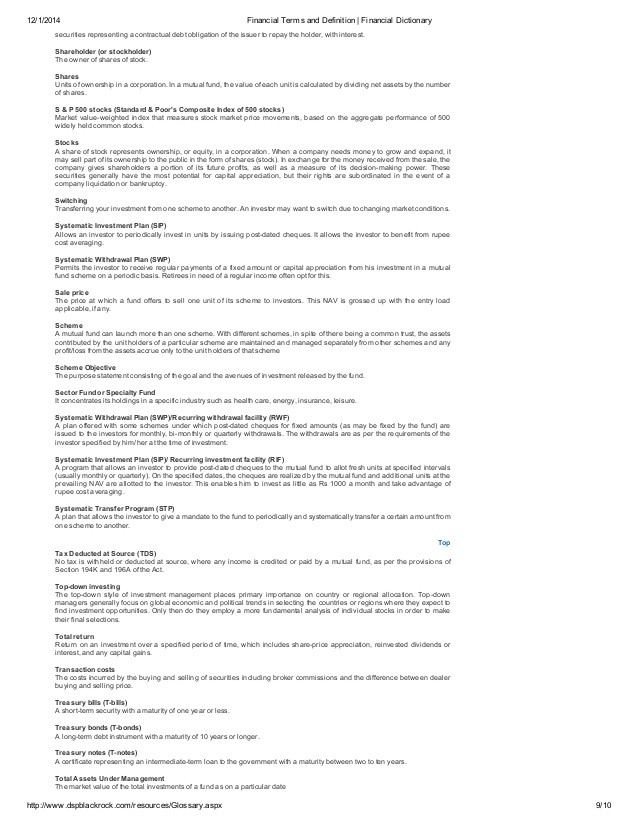Contingent deferred sales charge (Business) Definition Online Encyclopedia
Post on: 8 Август, 2015 No Comment

Contingent deferred sales charge (CDSC)
Days’ sales in inventory ratio
The average number of days’ worth of sales that is held in inventory.
Contingent Deferred Sales Charge
Sales charge taken if and when the investor redeems shares with the fund. Usually stated as a percentage of the amount withdrawn, and charged on a declining scale over a number of years, typically five to seven. Also known as a back-load..
contingent deferred sales charge. A pricing structure that imposes a sales charge when exiting a mutual fund.
contingent deferred sales charge Back-end sales load charged on a mutual fund, typically declining with the number of years the fund was held.
contingent premium option An option for which the premium is deferred to expiration and is paid only if the option expires in-the-money.
Contingent deferred sales charge
Practical Advice for Everyone on How to Save and Manage Money: No matter how old or young you are, there are some basic things you can do to better manage and protect your money. Here are recommendations from FDIC Consumer News. More.
CONTINGENT DEFERRED SALES CHARGE (CDSC)
In certain classes of mutual funds, a charge is made against the net asset value of the fund if the fund is redeemed within a predetermined time period. This back-end sales charge generally is reduced each year that the fund is owned.
Contingent deferred sales charge (CDSC)
An arrangement in which the money manager pursues an active bond portfolio strategy until an adverse investment experience drives the then-available potential return down to the safety-net level.
Also, unlike contingent deferred sales charge s, redemption fee s typically operate only in short, specific time periods, commonly 30, 180, or 365 days. However, some redemption fee s exist for up to five years. Charges are not imposed after the stated time has passed.
A claim that can be made only if one or more specified outcomes occur. Contingent deferred sales charge (CDSC)
The formal name for the load of a back-end load fund.
Contingent Deferred Sales Charge (CDSC)
A type of exit sales load which is charged when units are redeemed within a specific time period following their purchase. These charges reduce the longer the units are held.
Also known as a contingent deferred sales charge or load.
Investopedia Says:
The back-end load is a type of sales charge that is used with mutual funds that have share classes, which in this case are identified as Class B shares.
Also known as a contingent deferred sales charge or load.
Digging Deeper: The Mutual Fund Prospectus
How To Pick A Good Mutual Fund
January: Time To Read Your Mutual Fund’s Annual Report.
formal name for the back-end load is the contingent deferred sales charge. or CDSC.
Back-to-back financing An intercompany loan channeled through a bank.

Back-to-back loan A loan in which two companies in separate countries borrow each other’s currency for a.
75% of the sale, their no front end load-back end load fund s have a 7 year declining contingent deferred sales charge and they have other iterations of their funds making it so that there are up to 22 different all in fee and commission iterations on their funds.
Some mutual funds impose a back-end load. or a contingent deferred sales charge. if you sell shares in the fund during the first six or seven years after you purchase them. The charge is a percentage of the value of the assets you’re selling.
‘ A common back-end load is the ‘contingent deferred sales charge ‘ or ‘contingent deferred sales load ‘ (also known as a ‘CDSC’ or ‘CDSL’). The amount of this load will depend on how long the investment is held and typically decreases to zero if the investment is held long enough.
Similar financial terms
Contingent deferred sales charge (CDSC)
The formal name for the load of a back-end load fund.
Footnote R To be used by mutual funds with redemption fee s, contingent deferred sales charge s, or other charges deducted from net asset value upon redemption other than charges for special services such as wire transfer ).
If the charge is levied when you purchase the shares, it’s called a front-end load. If you pay when you sell shares, it’s called a back-end load or contingent deferred sales charge. And with a level load, you pay a percentage of your investment amount each year you own the fund.
Some back-end load fund s impose a full commission if the shares are redeemed within a designated time period after purchase, such as one year, reducing the commission the longer the investor holds the shares. The formal name for the back-end load is the contingent deferred sales charge. or CDSC.
The load tends to drop, perhaps by a percentage point each year, and then disappears altogether. However, the annual fees that the fund charges on Class B shares are higher than the fees on Class A shares. Back-end load s are also known as contingent deferred sales charge s (CDSC).
The intent of the redemption fee is to discourage rapid-fire shifts from one fund to another in an attempt to time swings in the stock or bond market. This fee often is confused with the contingent deferred sales charge. or back end sales charge, typically a feature of the broker-sold fund.
The formal name for the back-end load is the contingent deferred sales charge. or CDSC Back-testingCreating a hypothetical portfolio performance history by applying current asset selection criteria to prior time periods. Back-to-back financingAn intercompany loan channeled through a bank.
The formal name for the back-end load is the contingent deferred sales charge. or CDSC. [Harvey] back-to-back borrowing The process whereby a bank brings together a borrower and a lender so that they agree on a loan contract.














